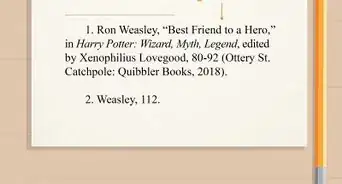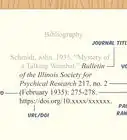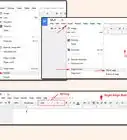This article was co-authored by Christopher Taylor, PhD. Christopher Taylor is an Adjunct Assistant Professor of English at Austin Community College in Texas. He received his PhD in English Literature and Medieval Studies from the University of Texas at Austin in 2014.
This article has been viewed 357,590 times.
MLA (Modern Language Association) format is a popular citation style for papers and essays. You may be unsure how to quote and cite play using MLA format in your essay for a class. Start by following the correct formatting for a quote from one speaker or from multiple speakers in the play. Then, use the correct citation style for a prose play or a verse play.
Steps
Template and Examples
Quoting Dialogue from One Speaker
-
1Include the author and title of the play. Before you launch into the dialogue from a character, name the author and the title of the play first. Include the author and title before the character's dialogue as a way of introducing the play to your reader.
- For example, if you were quoting a character from the play Who's Afraid of Virginia Woolf?, you would write, In Edward Albee's Who's Afraid of Virginia Woolf?, the character Honey says...
-
2Name the speaker of the quote. Whenever you quote from the play, make sure you note who said it in the play. Write the name of the speaker, followed by a present tense verb like “says,” “states,” “argues,” “notes,” or “claims.” Use a comma between the verb and the quote.
- For example, if you are quoting the character George from the play Who’s Afraid of Virginia Woolf? by Edward Albee, you would write, “George says,…” or “George states,…”.
Advertisement -
3Put the quote in quotation marks. Put quotation marks around the dialogue. This will let your reader know it is a quote from a text.[1]
- For example, if you are quoting from Who’s Afraid of Virginia Woolf?, you would write: Martha notes, "Truth or illusion, George; you don’t know the difference."
-
4Put slashes between verse lines. If you are quoting a play that is written in verse, use slashes to distinguish each line break. Put a space after each slash.[2]
- For example, if you were quoting from Shakespeare’s Measure for Measure, you would write: Claudio states “the miserable have no other medicine / But only hope.”
Quoting Dialogue from Multiple Speakers
-
1Put a blank space between the body of your paper and the first line. Separate the body of your paper and the quote with one blank line. This will let the reader know you are quoting from the play.[3]
- You do not need to use quotation marks when you are quoting dialogue by multiple speakers from a play. The blank space will act as a marker, rather than quotation marks.
-
2Indent the speaker names 1 inch (2.54 cm) from the left margin. Write the name of the speakers in all capitals, followed by a period. For example:[4]
- MARTHA. Truth or illusion, George; you don’t know the difference.
- GEORGE. No, but we must carry on as though we did.
- MARTHA. Amen.
-
3Indent the dialogue ¼ inch (0.63cm) from the left margin. If the character’s dialogue runs past one line, make sure you indent each line ¼ inch from the left margin.
- Verse dialogue is indented 1 ¼ inch (3.17cm) from the left margin.
-
4Include the stage directions. If there are stage directions in the dialogue, put them in as part of the quote. Use parentheses to notate the stage directions. Copy the punctuation as noted in the play. For example:
- RUTH. Eat your eggs, Walter.
- WALTER. (Slams the table and jumps up) --DAMN MY EGGS--DAMN ALL THE EGGS THAT EVER WAS!
- RUTH. Then go to work.
- WALTER. (Looking up at her) See--I’m trying to talk to you ‘bout myself--(Shaking his head with the repetition)--and all you can say is eat them eggs and go to work.
Citing a Quote from a Prose Play
-
1Put the citation in the text using parentheses. MLA formatting requires you to use in-text citations for prose plays. Place the citation at the end of the quoted text in parentheses.[5]
- If you are quoting dialogue from one speaker, place the citation at the end of the quoted dialogue, in the text.
- If you are quoting dialogue from multiple speakers, place the citation at the end of the block quote.
-
2Cite the author’s name. Note the author’s full last name first in the citation.[6]
- For example, you may write: “(Albee…)” or “(Hansberry…)”
-
3Note the title of the play. After the author’s last name, put in a comma. Then, write the title of the play you are quoting in italics.
- For example, you may write, “(Albee, Who’s Afraid of Virginia Woolf?...).”
- If you have mentioned the title of the play once already in an earlier citation in your essay, you do not need to mention it again in the citations for the play moving forward.
-
4Include the page number and the act number. Note where you found the quotation in the play. Write the page number after the author’s name, followed by a semicolon. Then, write the act number.
- For example, you may write, “(Albee 10; act 1).
- If you are including the title of the play, you may write: “(Albee, Who’s Afraid of Virginia Woolf? 10; act 1).”
Citing a Quote from a Verse Play
-
1Place the citation in-text. MLA format requires you to put citations for a verse play in the text of your essay. Use parentheses around the citation and place it at the end of the quotation.[7]
-
2Note the act number and the scene number. All verse plays will have acts and scenes that are ordered numerically. Write the act number, followed by a period. Then, write the scene number.[8]
- For example, if the quote appears in act 4, scene 4 of the play, you will write, “(4.4…)”.
-
3Include the line number or numbers. Verse plays are broken into lines. The lines are ordered numerically, starting at 1. Look for the line number or numbers for the quotation and include them in your citation.[9]
- For example, if the quote appears on lines 33 to 35, you will write, “(33-35).”
- The completed citation would look like: “(4.4.33-35)”.
Expert Q&A
Did you know you can get expert answers for this article?
Unlock expert answers by supporting wikiHow
-
QuestionHow do you cite Shakespeare quotes in MLA?
 Christopher Taylor, PhDChristopher Taylor is an Adjunct Assistant Professor of English at Austin Community College in Texas. He received his PhD in English Literature and Medieval Studies from the University of Texas at Austin in 2014.
Christopher Taylor, PhDChristopher Taylor is an Adjunct Assistant Professor of English at Austin Community College in Texas. He received his PhD in English Literature and Medieval Studies from the University of Texas at Austin in 2014.
English Professor
-
QuestionHow do you cite a play title in an essay?
 Christopher Taylor, PhDChristopher Taylor is an Adjunct Assistant Professor of English at Austin Community College in Texas. He received his PhD in English Literature and Medieval Studies from the University of Texas at Austin in 2014.
Christopher Taylor, PhDChristopher Taylor is an Adjunct Assistant Professor of English at Austin Community College in Texas. He received his PhD in English Literature and Medieval Studies from the University of Texas at Austin in 2014.
English Professor
-
QuestionHow do you cite Shakespeare in text?
 Christopher Taylor, PhDChristopher Taylor is an Adjunct Assistant Professor of English at Austin Community College in Texas. He received his PhD in English Literature and Medieval Studies from the University of Texas at Austin in 2014.
Christopher Taylor, PhDChristopher Taylor is an Adjunct Assistant Professor of English at Austin Community College in Texas. He received his PhD in English Literature and Medieval Studies from the University of Texas at Austin in 2014.
English Professor
References
- ↑ http://penandthepad.com/quote-essay-using-mla-format-4509665.html
- ↑ https://www.ivcc.edu/stylebooks/stylebook4.aspx?id=14662
- ↑ https://www.ivcc.edu/stylebooks/stylebook4.aspx?id=14662
- ↑ https://www.ivcc.edu/stylebooks/stylebook4.aspx?id=14662
- ↑ http://penandthepad.com/quote-essay-using-mla-format-4509665.html
- ↑ http://penandthepad.com/quote-essay-using-mla-format-4509665.html
- ↑ http://penandthepad.com/quote-essay-using-mla-format-4509665.html
- ↑ https://www.ivcc.edu/stylebooks/stylebook4.aspx?id=14662
- ↑ https://www.ivcc.edu/stylebooks/stylebook4.aspx?id=14662
About This Article
To quote and cite a play in your essay using MLA format, start by referencing the author and title of the play in the main body of your essay. Then, name the speaker of the quote so it’s clear who’s talking. For example, write, “In Edward Albee’s Who’s Afraid of Virginia Woolf? the character Honey says…” After introducing the quote, frame the dialogue with quotation marks to make it clear that it’s a direct quote from a text. If your dialogue is written in verse, use forward slashes to indicate each line break. For more tips from our English co-author, including how to quote dialogue between multiple speakers in your essay, read on!


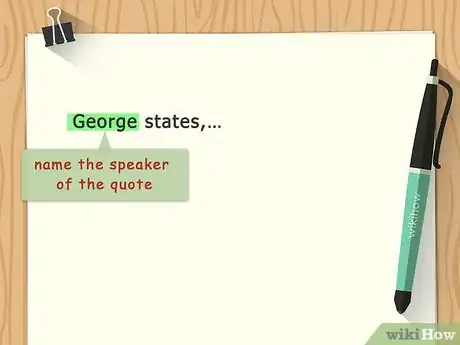
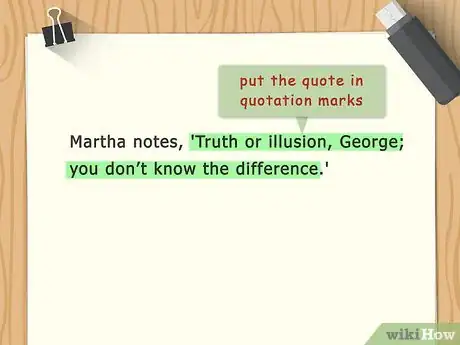
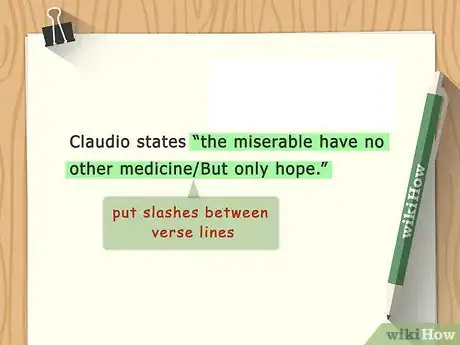
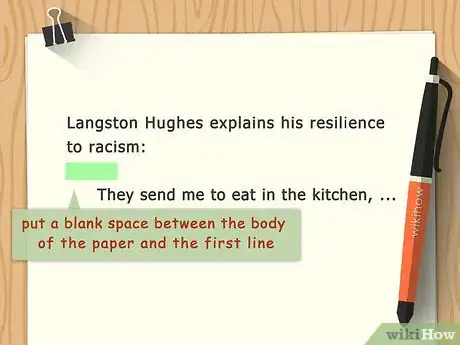
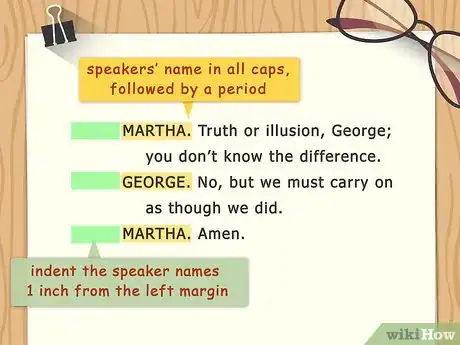
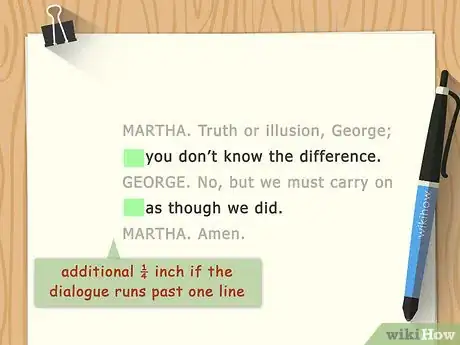
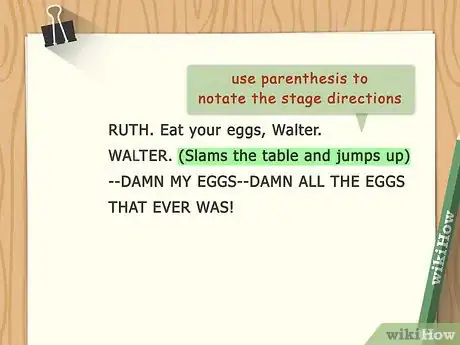
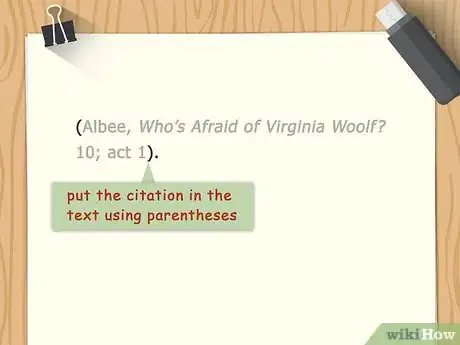
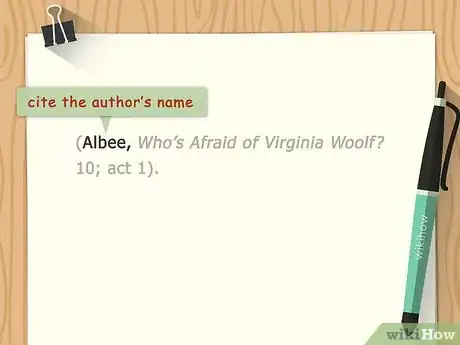
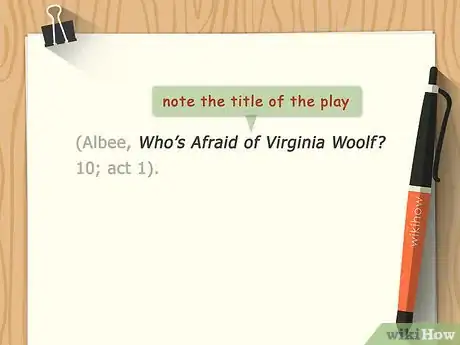
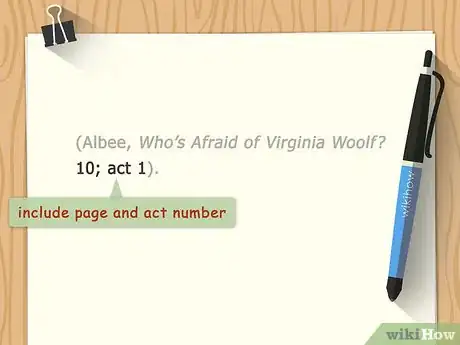
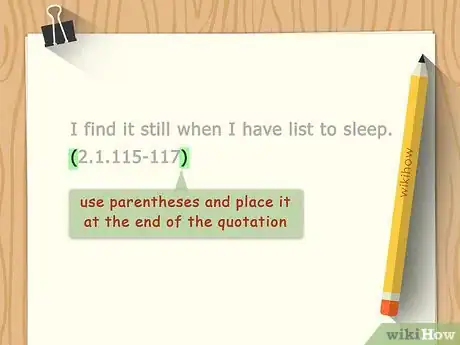
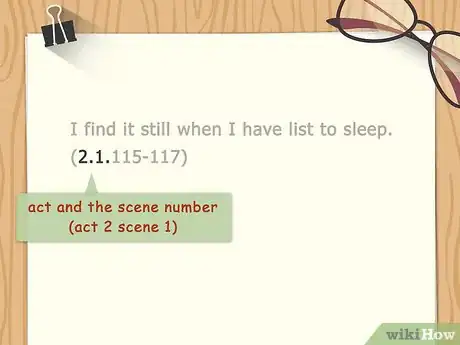
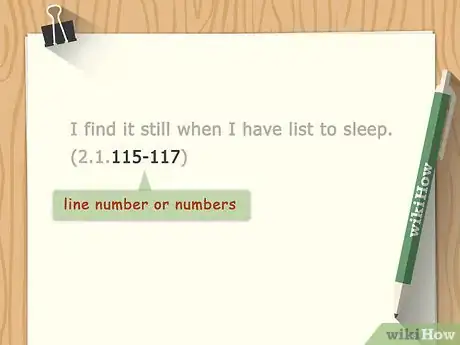

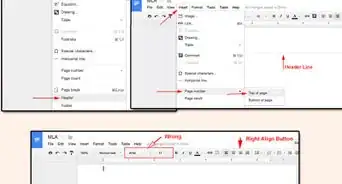




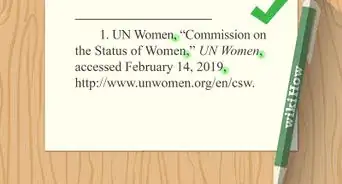


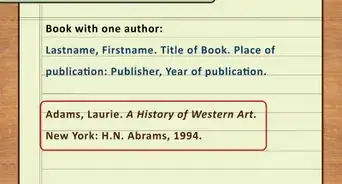


-Step-18.webp)
